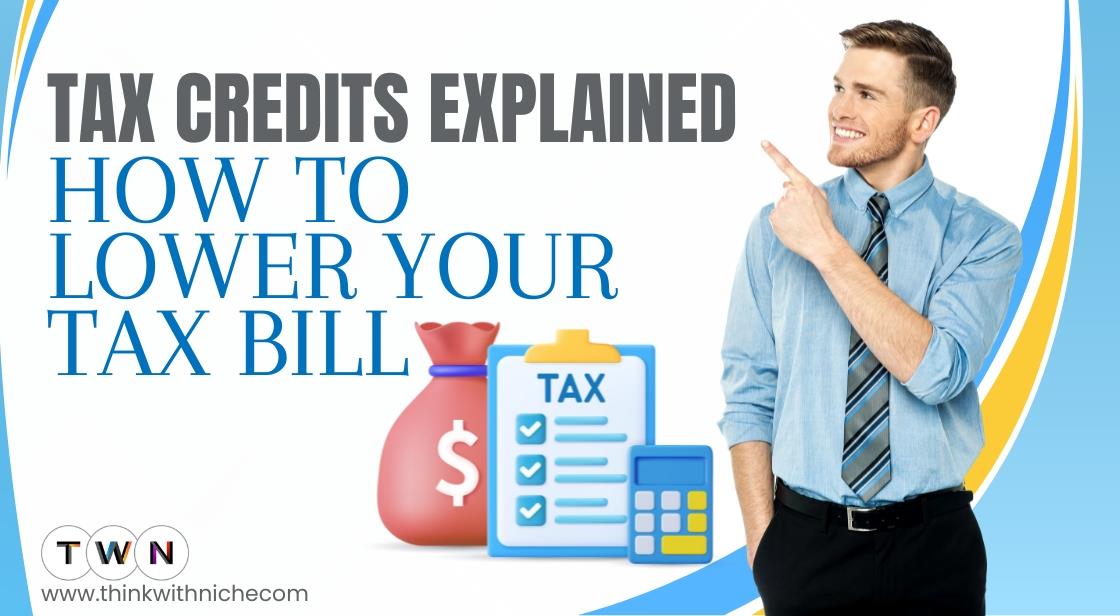Tax Credits Explained: How to Lower Your Tax Bill

Blog Post
As the annual tax season draws near, individuals across the country are gearing up to tackle their tax obligations. Amidst the complexities of tax filing, one often underutilized strategy for minimizing tax liabilities is the utilization of tax credits.
Understanding the nuances of tax credits – how they function, the various types available, and eligibility criteria – is crucial for taxpayers looking to optimize their financial situation. In this comprehensive guide, we delve into the intricacies of tax credits, offering insights into their significance and practical applications.
From federal to state credits, we explore the mechanisms through which taxpayers can leverage these incentives to lower their tax bills effectively.
Whether you're a seasoned taxpayer well-versed in tax regulations or a newcomer navigating the labyrinth of tax laws for the first time, this article aims to provide clarity and actionable strategies for maximizing tax savings.
By demystifying the concept of tax credits and providing practical guidance on identifying and claiming eligible credits, readers will gain the confidence and knowledge needed to navigate tax season with ease and potentially unlock substantial savings.
With tax season just around the corner, it’s time to look at ways to reduce your tax bill. While taking on this process can be a scary thought, it’s not that difficult once you put some effort into it.
Through tax credits, you can lower your taxes year after year. Whether you file your taxes on your own or get them done with the help of an accountant, the following overview of tax credits can help you make the most out of these tax rewards that are offered by the government.
What are tax credits?
Tax credits refer to a dollar amount that taxpayers can claim on their annual tax filing. You can get tax credits through the federal government or the state government for both federal and state taxes, respectively. You can use any available tax credits to lower your tax bill every year. This makes it important for you to learn about tax credits and their usage while building a strong personal finance plan for yourself.
How do tax credits work?
Unlike some tax benefits or deductions that reduce your total taxable income, tax credits are a dollar-for-dollar claim against your tax bill. This means that if you have a tax credit of $1,000 and your tax bill is $1,100, you can reduce your tax payment to $100. This makes tax credits a crucial part of tax filing, whether you are doing it through a mobile app or through a professional accountant’s tax preparer software.
Make sure your quarterly tax payments correspond to your real income and spending when filing after an extension. You may need to make further payments in order to avoid fines if you underpaid. If you paid more than necessary, though, you can write off the difference from your future tax obligations.
What are refundable tax credits?
Once you have used tax credits to lower your tax bill, you can get refundable tax credits in your tax refund. For example, if you have a tax credit of $1,000 and your tax bill is $900, you can first reduce your tax bill to zero and then get the remaining $100 refunded to you. While not all tax credits are refundable, some of them are. This information helps you easily manage your finances in your budget planner.
Also Read: Discover the Top Business Accounting Software for Your Company
What are carryover tax credits?
Carryover tax credits refer to dollar-amount credits that you can carry forward to the next tax year. This means that once you have reduced your tax bill to zero but still have some tax credits remaining, you don’t have to exhaust them before the turn of the calendar. It’s important to recheck which federal and state tax credits have this perk so you can stay well away from making common financial mistakes.
What types of tax credits are available?
You can earn tax credits in a variety of ways. This ranges from caring for a child to installing solar energy equipment in your home. Some of the most popular tax credits include the child tax credit (CTC), the child and dependent care credit (CDCC), and the earned income tax credit (EITC). Similar to using a coupon app to see all available offers in your area, you can do your research to see which credits are there for you to claim.
How do you know which tax credits you can claim?
While learning about different credits is easy, it can be a bit difficult to figure out which ones apply to you. But it’s not impossible. You can read guides by the Internal Revenue Service (IRS) to check your eligibility for tax credits. If that seems a bit overwhelming to you, you can follow a common suggestion from top personal finance books and speak to finance professionals to get accurate answers.
Can you sell your tax credits?
You can sell certain types of tax credits, like those for solar energy installation, to someone else. But there are some conditions that you need to meet, including receiving the payment in cash. With that, the person who buys the tax credits from you cannot resell them again.
To ensure that you handle this sensitive matter properly, you might want to speak to tax accountants before thinking of using this money through your online bank account.
After going through this quick guide, you can learn how to avail of tax credits to manage your tax bill with more relief. This can help you find the financial freedom that you deserve in the long run.
You May Like
EDITOR’S CHOICE












